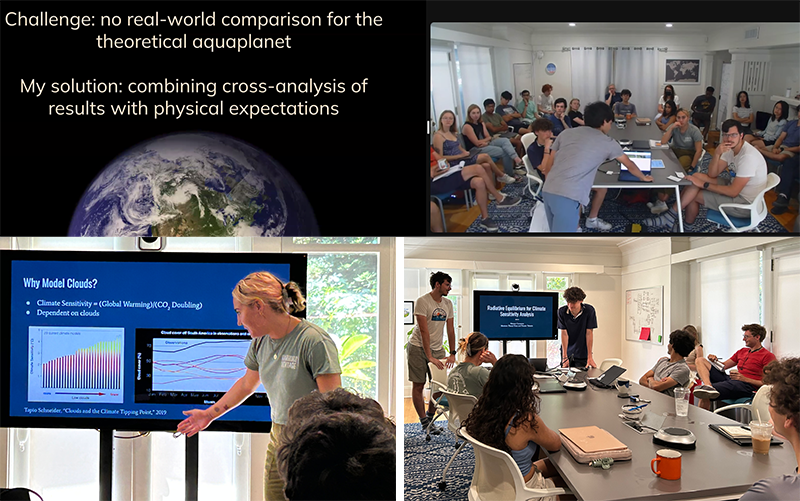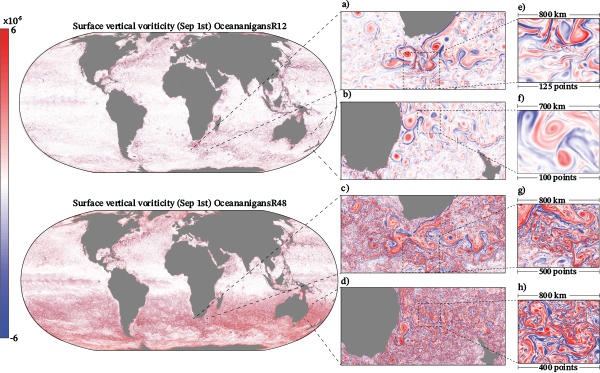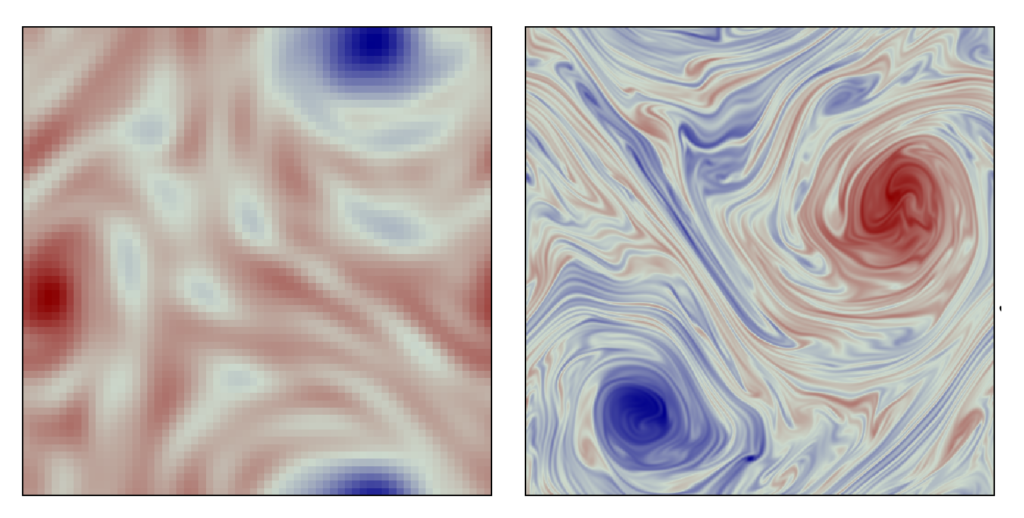
|
Our latest updates and news
|
How to Assess Weather and Climate Risks
|
|
Climate change is causing a noticeable shift in the risks associated with weather and climate hazards worldwide. Despite this, existing climate models struggle to provide the precise predictions with quantified uncertainties that are required for comprehensive climate risk assessments. Two recent reports present a way forward to address this issue.
The President’s Council of Advisors on Science and Technology (PCAST) issued a report title “Extreme Weather Risk in a Changing Climate: Enhancing prediction and protecting communities.” This report–-produced by a PCAST working group on climate risks on which Tapio Schneider served—advocates for large ensembles of moderately high-resolution climate simulations (10-25 km resolution) as a foundation for improved climate risk assessments.
Similarly, in a recent piece in Nature Climate Change, CliMA scientists Tapio, Raffaele Ferrari, and Andrew Stuart, along with 11 colleagues from around the world, highlight the importance of leveraging artificial intelligence together with domain-specific expertise to generate ensembles of climate simulations with quantified uncertainties. They can serve as anchors for more detailed downstream hazard models, for example, for floods and wildfires. CliMA has adopted this approach, focusing on turning this vision into reality. Here, we summarize some recent developments that highlight our progress in achieving this goal.
|
|

CliMA’s summer students are advancing climate modeling and prediction–and are learning about the climate system along the way
|
Summer 2023 Undergaduate Student Research
For a span of 10 enriching summer weeks, CliMA is proudly hosting an exuberant and dynamic cohort of over a dozen summer students. They have come to CliMA through programs such as Caltech’s Summer Undergraduate Research Fellowship (SURF) and MIT’s Undergraduate Research Opportunity Program, with most of the Caltech fellowships being made possible through the generous contributions of two dedicated CliMA supporters.
The summer students are passionately engaged in the development, documentation, and rigorous testing of diverse climate model components. Their scope covers areas ranging from microphysics parameterizations to the creation of effective machine learning emulators. They are actively conducting simulations of the atmosphere, oceans, and land, to analyze and improve the behavior of climate model components.
In a recent highlight, the SURF students from Caltech showcased the outcomes of their individual projects to the CliMA team, in preparation for their capstone presentations to their mentors and fellow SURF students across campus. |
|
The Fastest Ocean Model
CliMA’s ocean team at MIT has developed the world's fastest ocean model on GPUs, enabling decade-long global simulations at 8 km resolution (see Figure). In this so-called eddy-rich regime, a global computation requires sixty-eight modern GPUs to achieve one decade per day throughput. This performance, on relatively modest hardware resources, suggests that climate simulations of the sort undertaken by IPCC initiatives could shift to fully eddy-resolving ocean modeling in the near future. This represents a major breakthrough in climate modeling. Eddies control the ocean uptake of heat and carbon, but they have proven very hard to accurately parameterize. This has resulted in large biases in climate simulations, which can now be mitigated with increased resolution.
The next challenge is to maintain the same level of performance once we add sea-ice and biogeochemistry components to the ocean model. Simone Silvestri and Gregory Wagner with help from the rest of the team are up for the challenge. |

Global maps of modeled vertical vorticity [1/s] generated with the CliMA ocean model at 1/12 and 1/48 degree horizontal resolutions. The plots shown are for the end of the Southern Hemisphere winter. The upper panels show the eddy-rich regime described in the text. The lower panels show that at even smaller scales the eddies result in a rich web of fronts in the winter hemisphere upper ocean, the so-called submesoscale regime. Zoomed-in plots of the Agulhas current region and the East Australia current region again highlight the difference between mesoscale and sub-mesoscale resolution simulations. The CliMA ocean model is so fast that we can simulate both the eddy-rich and submesoscale regimes for years and shed light on the longstanding questions about the impact of submesoscale turbulence on climate. |
|
Using Generative AI for Downscaling of Climate Model Output |
|
Most current climate models use grid cells around 100 km x 100 km in size, roughly equivalent to the area of Los Angeles County. This coarse-grained view does not provide the detailed predictions we need to assess risks of local climate change impacts. For instance, it doesn't tell us much about the risks of heavy rainfall and flooding in the foothill communities of eastern Los Angeles County.
|

Snapshots of vorticity at different resolutions |
|
There are computationally expensive dynamical downscaling methods that nest high-resolution models in coarse-resolution climate models. There are also computationally cheaper statistical downscaling methods that can also correct biases in coarse-resolution models; however, they struggle with analyzing, for example, compound events, such as intense rainfall following prolonged drought and triggering mudslides.
Over several months, CliMA’s Senior Research Scientists Katherine Deck and Toby Bischoff have developed an alternative approach that can be used with many variables simultaneously and hence is suitable for analyzing compound events. They have created a new method that is based on the same generative AI that powers large language models such as ChatGPT and that adds detail to and reduces the biases in climate model output.
These downscaling tools are envisioned for postprocessing our climate model output. They will eventually help individuals, businesses, and governments make informed choices about weather and climate risks.
More details in Katherine’s blog post. |
|
The Gravity Wave Parameterizations Learning Curve
CliMA Senior Research Scientists Zhaoyi Shen and Lenka Novak, along with former Research Scientist Jia He, have a longstanding collaboration to develop physics-AI hybrid parameterizations for the CliMA model. These parameterizations account for processes that are too small in scale to be resolved by global models. One example is gravity waves, which are generated when mountains or upward motions inside towering thunderstorm clouds disturb the large-scale atmospheric flow. Their wavelengths range from kilometers (which is unresolvable in global climate models) to thousands of kilometers.
Jia, Zhaoyi, and Lenka reviewed different ways in which gravity wave effects have been represented; they remain highly uncertain. They implemented physics-based parameterizations and are reducing uncertainties in them by informing the parameterizations with observations, using the data assimilation and machine learning tools developed at CliMA. They are collaborating with Laura Mansfield and Aditi Sheshadri from Stanford’s DataWave VESRI project, who have already shown promising results in idealized numerical experiments.
The team continues to collaborate on other parameterizations for the atmosphere model. Their guiding principle is to use physical principles as far as possible to make parameterization schemes interpretable and generalizable, and learn what remains from data. |
CliMA’s Clean Code
In scientific computing, code in a high-level language such as Python is typically used for the development and testing of concepts and ideas, as well as for post-processing of model output. But for the main production work, a faster, lower-level language such as C++ or Fortran (the standard in climate modeling) is used. CliMA wanted a modern approach, using one language for everything from initial conceptualization to post-processing, to help especially early-career scientists and engineers to get involved.
The CliMA model is created using the Julia programming language. Julia is flexible, works well with GPUs with minimal extra code, and is efficient for both initial conceptualization and performant production code. Charlie Kawczynski, a Senior Software Engineer at CliMA, said, “Julia allows us to prototype rapidly, with the tools available in the Julia ecosystem, and proceed directly to building fast code from the prototypes, without giving up the readability of a high-level language.”
Here is one example showing how much more readable our high-level Julia code is that performs the same computations as a Fortran code from another climate model: |
 Examples of Fortran and Julia code for similiar functions |
CliMA Special Collection in JAMES
We are beginning to roll out a series of papers describing the CliMA models and model components we have developed in a Special Collection in the Journal of Advances in Modeling Earth Systems, the premier journal for climate modeling. So far, we have 19 papers planned, 10 in development, and 1 submitted. Among other topics, the papers will cover CliMA’s approach to
- Earth system modeling
- Ocean models and parameterizations
- Atmosphere models and parameterization
- Land hydrology and biosphere models
- Calibration and uncertainty quantification in climate models.
The Special Collection will accept papers for the coming 2 years. |
|
|
|
|
|
|